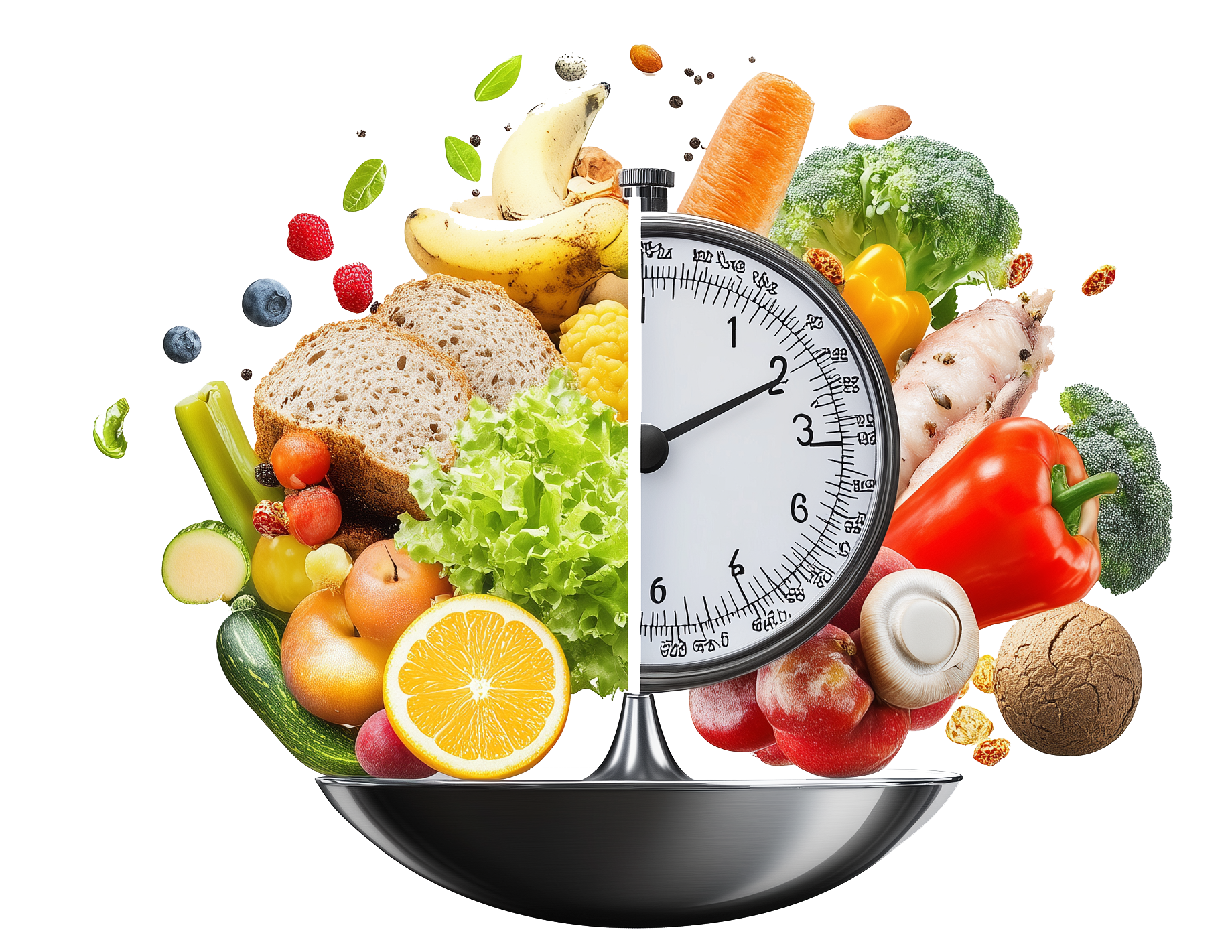Who Is This Article For?
What Will You Gain From This Article?
- Understand what a calorie deficit is and why it’s crucial for weight loss.
- Learn how to calculate your personal calorie needs and set a realistic goal.
- Discover practical tips for achieving a calorie deficit through simple dietary changes and increased activity.
Hey there! If you're reading this, chances are you're looking for a way to lose weight without getting sucked into the latest fad diet or spending hours at the gym. I get it—I've been there too. The idea of shedding those extra pounds can feel overwhelming, especially with all the conflicting advice out there. But what if I told you that weight loss doesn’t have to be complicated? In fact, it can be as simple as creating a calorie deficit.
In this post, I’m going to walk you through everything you need to know about calorie deficits—what they are, how to calculate yours, and most importantly, how to use them to lose weight in a healthy and sustainable way. By the end of this article, you'll have a clear action plan to start burning 500 calories a day and seeing real results. So grab a cup of coffee (or tea!) and let’s dive in.
1. What is a Calorie Deficit?

2. How to Calculate Your Calorie Deficit
Now that we know what a calorie deficit is, let’s figure out how to create one that works for you. Everyone’s body is different, so what works for your friend might not work for you—and that’s okay! The goal here is to find a calorie deficit that’s sustainable and fits into your lifestyle.
Step 1: Calculate Your Maintenance Calories
Your maintenance calories are the number of calories your body needs each day to maintain its current weight. This number depends on factors like your age, gender, height, weight, and activity level.
The easiest way to calculate your maintenance calories is by using an online calculator (just Google “calorie maintenance calculator,” and you’ll find plenty). These calculators use something called the Harris-Benedict equation to estimate your daily calorie needs based on your Basal Metabolic Rate (BMR) and activity level.
For example:
- If you’re a 30-year-old woman who weighs 150 pounds and exercises moderately (3-4 times per week), your maintenance calories might be around 2,000 per day.
- If you’re a 40-year-old man who weighs 200 pounds and has a desk job with little exercise, your maintenance calories might be closer to 2,500 per day.
Step 2: Decide on Your Calorie Deficit
Once you know your maintenance calories, it’s time to create your deficit. A safe and sustainable calorie deficit is typically between 300-500 calories per day. This will allow you to lose weight steadily without feeling deprived or overly hungry.For example:
- If your maintenance calories are 2,000 per day, aim for 1,500-1,700 calories per day.
- If your maintenance calories are 2,500 per day, aim for 2,000-2,200 calories per day.
A 500-calorie daily deficit will result in about 1 pound of fat loss per week, which might not sound like much at first—but trust me, slow and steady wins the race when it comes to sustainable weight loss!


3. Methods to Achieve a Calorie Deficit
Okay, so now we know what a calorie deficit is and how much of one we need—but how do we actually achieve it? There are two main ways: eating fewer calories and burning more calories through physical activity. Ideally, you’ll want to do a combination of both for the best results.
Eat Less: Smart Ways to Cut Calories
Cutting calories doesn’t mean starving yourself or eating nothing but lettuce all day. In fact, extreme calorie restriction can backfire by slowing down your metabolism and making you feel miserable (hello hanger!). Instead, focus on making small changes that add up over time:
- Portion Control: You don’t have to give up your favorite foods—just eat smaller portions! Try using smaller plates or bowls so your meals look bigger without adding extra calories.
- Swap High-Calorie Foods: Love snacking on chips or cookies? Swap them for lower-calorie alternatives like air-popped popcorn or fruit. You’ll still satisfy your cravings without blowing your calorie budget.
- Avoid Sugary Drinks: One of the easiest ways to cut calories is by ditching sugary drinks like soda and juice. These drinks are packed with empty calories that don’t fill you up but can quickly add up over time.
- Fill Up on Veggies: Vegetables are low in calories but high in fiber and nutrients—meaning they’ll fill you up without adding many extra calories. Try loading half of your plate with veggies at each meal.

Move More: Burn Extra Calories
Exercise can help boost your calorie burn and speed up weight loss—but don’t worry if hitting the gym isn’t your thing! There are plenty of ways to move more throughout the day without feeling like you're working out:
- Walk More: Walking is one of the easiest ways to burn extra calories without even thinking about it. Try parking farther away from stores or taking short walks during breaks at work.
- Take the Stairs: Ditch the elevator and take the stairs whenever possible—it’s an easy way to get your heart rate up and burn some extra calories.
- Do Short Workouts: If you don’t have time for long workouts, try doing short bursts of activity throughout the day. Even just 10 minutes of bodyweight exercises like squats or push-ups can make a difference!

Track Your Progress
One of the best ways to stay on track with your calorie deficit is by tracking what you eat and how much you move each day. There are tons of apps out there (like MyFitnessPal) that make tracking easy—you can log your meals and exercise in just a few taps!

4. Common Mistakes to Avoid
Now that we’ve covered how to create a calorie deficit let’s talk about some common mistakes people make when trying to lose weight—and how you can avoid them.
Mistake #1: Over-restricting Calories
It might be tempting to slash your calories as much as possible in hopes of losing weight faster—but trust me when I say this is not a good idea! When you cut too many calories too quickly (think less than 1,200/day), your body goes into starvation mode and starts holding onto fat instead of burning it.
Solution: Stick with a moderate calorie deficit (300-500/day) so that you're losing fat while still giving your body enough fuel.
Mistake #2: Ignoring Hidden Calories
It’s easy to forget about those “little” things we eat throughout the day—like cream in our coffee or snacks from the office candy jar—but those hidden calories can add up fast!
Solution: Be mindful of everything you eat and drink throughout the day—even if it seems small—and try tracking everything for at least one week so that you're aware of where extra calories might be sneaking in.
Mistake #3: Focusing Only on Calories
While creating a calorie deficit is essential for weight loss—it’s not just about cutting back on food! Your body still needs nutrients like protein (to build muscle), healthy fats (for brain function), and carbs (for energy).
Solution: Focus on eating nutrient-dense foods rather than just cutting back on everything across the board—this will help keep hunger at bay while ensuring you're getting all necessary vitamins/minerals!

5. What Results Can You Expect?
So…what kind of results can YOU expect from following this plan?
If you're sticking with around a 500-calorie daily deficit consistently—you should expect around one pound per week lost—which may not seem like much initially but adds up over time!Beyond just seeing numbers drop though—you'll likely notice other benefits too:
- Increased energy level
- Better mood
- Improved sleep quality
- Healthier skin/hair/nails
And perhaps most importantly—you'll feel more confident knowing YOU have control over YOUR health journey!

6. Staying Consistent: Tips for Long-Term Success
- Set realistic goals—don’t expect overnight results!
- Celebrate small wins along way—noticing progress keeps motivation high!
- Find accountability partners whether friends/family/social media groups!
- Adjust intake/exercise routine based upon progress plateau stages!
- Remember why started journey initially whenever feel discouraged!


Thank you for sharing this valuable information! A great starting point for anyone looking to lose weight healthily. It’s well-structured, informative, and encouraging.
And it is an excellent resource for anyone looking to understand and implement a calorie deficit for weight loss. It’s comprehensive, clear, and offers practical advice that’s easy to follow.
Thank you for your kind words! I’m delighted to hear that you found the article helpful and well-structured. Understanding and implementing a calorie deficit is indeed a fundamental aspect of healthy weight loss. If you have any questions or need further guidance on this topic, feel free to ask. Your feedback is greatly appreciated!
You did such a great job breaking down the idea of a calorie deficit in a way that’s super easy to understand. I love how you explained that it’s not about starving yourself but about making small, manageable changes to your diet and activity levels. The example with tracking calories and being mindful of portion sizes really hit home for me—it makes the whole process seem doable, even for someone who’s just getting started.
Thank you so much for your kind words! I’m glad to hear that the article made the idea of a calorie deficit easy to understand. It’s all about making small, manageable changes to your diet and activity levels, rather than starving yourself. Being mindful of portion sizes and tracking calories can make the process more doable, even for beginners. If you have any questions or need more tips, feel free to ask. Wishing you success on your health journey!
This is great as it is straightforward and practical. It outlines effective strategies for achieving a calorie deficit and breaks down the concept into easily digestible tips, focusing on both diet and exercise to help people reach their weight loss goals.
From my experience, maintaining a calorie deficit was key to my weight loss journey, but combining it with regular workouts certainly made a difference in my results. The practical advice provided here can be easily implemented into daily routines.
What are your thoughts on the sustainability of maintaining a 500-calorie deficit in the long term? I can see your tips here but is it more of building a process habitually?
Thank you for your comment! I’m really glad to hear you found the tips practical and easy to follow. You’re absolutely right—combining a calorie deficit with regular exercise often leads to better and more consistent results. Exercise not only boosts your calorie burn but also supports overall health and energy levels during weight loss.
As for sustaining a 500-calorie deficit over the long term, it’s generally safe and effective for gradual weight loss, but it’s important to pay attention to how your body responds. Everyone’s needs are different, so adjustments might be necessary if you feel fatigued or notice other changes.
Building lasting habits is definitely the key here. Incorporating small, consistent changes to your daily routine, like meal prepping or scheduling regular workouts, can make the process feel more natural and sustainable in the long run.
Thanks again for sharing your experience and asking such a great question—it’s insights like yours that make these discussions so valuable!
Great post! I love how you break down the concept of a calorie deficit into such simple steps—it’s so much less intimidating that way. The tips on avoiding extreme restriction and hidden calories are super helpful for staying consistent without feeling deprived!
Getting rid of the sugary drinks is a great first start to this deficit. Sugar that isn’t burned automatically turns to fat. So that’s good advice
Thank you for your kind words! I’m so glad you found the breakdown helpful and easy to follow. Simplifying the concept really does make it less overwhelming, and focusing on small, consistent changes can make all the difference.
Cutting out sugary drinks is an excellent first step! You’re absolutely right—those hidden liquid calories can quickly add up, and reducing sugar intake not only helps with calorie control but also improves overall health. Staying mindful of these little changes can lead to big results over time.
Thanks for sharing your thoughts! It’s great to see others resonate with these tips. Keep up the great work!
Hi Maxon,
I appreciate your comprehensive guide on creating a calorie deficit for weight loss. Your article successfully breaks down a complex topic into digestible, actionable information that readers can use. Your article provides an excellent foundation for anyone starting their weight loss journey. The combination of scientific principles with practical, real-world advice makes it both informative and actionable. Would you consider writing a follow-up piece addressing some of these additional aspects? I believe your readers would benefit from this expanded perspective.
All the Best,
Eric
P.S. The section on common mistakes is particularly helpful, perhaps this could be expanded into its own detailed article.
Hi Eric,
Thank you so much for your thoughtful feedback and kind words about the article! I’m truly glad to hear that you found it both informative and actionable—it’s always my goal to make complex topics easy to understand and apply.
Your suggestion for a follow-up article is an excellent idea! Addressing additional aspects of creating a calorie deficit could certainly help readers deepen their understanding and further support their weight loss journey. I’ll take your suggestion into consideration for future posts. If you have specific topics or questions in mind, feel free to share them—I’d love to address them!
Thanks again for your support and engagement!
Thank you for this article. I had never thought about ‘calorie deficiency’ as a means for weight loss. You have broken it down into bite size pieces that are very easy to understand. This is a great article for beginners and pros alike as it demonstrates not only the ‘what to do’ but the ‘how to do it correctly’ approach. I like that you mention physical exercise as well as diet. I might also add a multivitamin routine for help in balancing nutritional needs, especially in the elderly.
Thank you so much for your kind words and thoughtful feedback! I’m glad to hear that the article was easy to understand and helpful for both beginners and more experienced readers.
You’ve made an excellent point about incorporating a multivitamin routine, especially for the elderly, to help balance nutritional needs. A well-rounded approach that combines diet, physical exercise, and proper supplementation is indeed essential for achieving long-term health and weight loss goals.
Your insights are very much appreciated, and they add great value to the discussion. If you have any other suggestions or topics you’d like us to explore further, please feel free to share. Thank you for being an engaged reader, and I wish you continued success on your wellness journey!
Hello,
This post is packed with practical and easy-to-follow tips—thank you for breaking down the calorie deficit concept in such an approachable way! I especially appreciate the balance between cutting calories and incorporating movement without over-restricting or overcomplicating the process. The advice on avoiding common mistakes, like hidden calories and nutrient imbalances, really stood out to me.
The focus on sustainable, long-term changes rather than quick fixes is refreshing and motivating. Slow and steady truly wins the race and this guide provides all the tools to make that journey achievable.
Great read—definitely bookmarking this one!
Thank you so much for your thoughtful and encouraging comment! I’m thrilled to hear that you found the post helpful and practical. Breaking down complex topics into simple and actionable steps is something I strive for, so it’s great to know it resonated with you.
I’m glad you appreciated the balance between mindful calorie reduction and movement, as well as the emphasis on avoiding common pitfalls like hidden calories and nutrient imbalances. Sustainable, long-term changes really are the key to lasting results, and it’s wonderful to hear that this approach feels motivating to you.
Thank you for bookmarking the post—it’s always my goal to create content that people can refer back to on their journey. If you have any other questions or topics you’d like to see covered, feel free to share your thoughts. Wishing you all the best in achieving your goals!
This article is a breath of fresh air for those of us who are tired of extreme diets and complicated fitness plans. It’s great to see a straightforward approach to weight loss that emphasizes sustainability.
I particularly like the emphasis on not just cutting calories, but also on making smart food choices and increasing activity in everyday life.
One thing I’m curious about: how can we ensure we’re getting enough nutrients while maintaining a calorie deficit?
Thanks for the practical advice and keeping it real!
Thank you so much for your kind words and thoughtful feedback! I’m thrilled to hear that you found the article refreshing and practical. Weight loss doesn’t have to be overly complicated, and I’m glad the simplicity of the approach resonated with you.
You’ve brought up an excellent point about ensuring proper nutrition while maintaining a calorie deficit. It’s crucial to focus on nutrient-dense foods, like fruits, vegetables, lean proteins, whole grains, and healthy fats. These foods not only provide essential vitamins and minerals but also help keep you feeling full and energized throughout the day.
Another helpful tip is to plan your meals in advance. This can ensure a good balance of macronutrients and prevent accidental over-restriction of certain food groups. If needed, consulting a dietitian can also be a great way to tailor your diet to meet your individual needs while staying within your calorie goals.
Thank you once again for your positive feedback and thoughtful question. It’s readers like you who make sharing this content so rewarding! 😊
This is a great explanation of what a calorie deficit is. The only way to lose weight is to consume less than what you burn. And although one can start an exercise regime to increase the amount of calories that you burn, you still need to eat less than what your body uses.
It is a great tip to use a smaller plate or bowl to reduce your portions size. And never go back for seconds, is something that I try to do.
You mention using a calorie maintenance calculator and that one can Google it, but do you have a link that you can include to make it easier for your readers? Thank you.
Thank you for your thoughtful feedback. I’m glad you found the explanation of calorie deficits helpful and that the portion control tips, like using smaller plates and avoiding second servings, resonate with you.
Regarding your suggestion about including a direct link to a calorie maintenance calculator, I appreciate the idea and will incorporate it into the article to enhance reader convenience. In the meantime, you might find this Calorie Calculator useful for estimating daily calorie needs.
Thank you again for your valuable input.
Wow! This is a great article. I love the detail and the imagery. I enjoyed that it felt like you were having a conversation with me and helping me understand not only what I would learn but also how to figure out my calorie deficit. You gave great instructions and insights on how to figure things out, including helpful tips on mistakes to avoid.
Thank you so much for your kind words and thoughtful feedback! I’m truly glad to hear that you enjoyed the article and found it both informative and conversational. My goal is to make complex topics simple and relatable, so it’s wonderful to know that the instructions and tips resonated with you.
Helping readers avoid common mistakes is something I aim for, so I’m delighted that part stood out to you. If you have any questions or need further clarification on any of the points, feel free to reach out—I’m here to help. Wishing you great success on your journey to achieving your goals!
Hello Maxon Tan!
This article does a fantastic job of breaking down the concept of a calorie deficit in a way that feels approachable and realistic! I appreciate how it emphasizes sustainable habits over crash dieting, which is so important for long-term health.
One thing I’m curious about is how to balance a calorie deficit with maintaining energy levels, especially for those with demanding schedules or active lifestyles. Do you have any recommendations for snacks or meals that are low in calories but still provide enough fuel to keep up with daily tasks?
Also, the section about tracking food intake was really helpful—do you have a preferred app or method for keeping track of calories that you’d recommend to beginners?
Thanks for such an insightful guide! It’s encouraging to see a focus on healthy and practical approaches to weight loss.
Angela M 🙂
Hello Angela M,
Thank you so much for your thoughtful and encouraging feedback! I’m glad to hear that you found the article insightful and approachable—it’s always rewarding to know it resonates with readers like you.
Balancing a calorie deficit with maintaining energy levels can indeed be challenging, especially for individuals with active lifestyles or packed schedules. For snacks, I recommend options like Greek yogurt with a handful of berries, a small portion of nuts (almonds or walnuts), or sliced vegetables with hummus. These are nutrient-dense choices that provide sustained energy without adding too many calories.
For meals, focus on lean proteins like chicken breast, tofu, or fish paired with complex carbohydrates such as quinoa, brown rice, or sweet potatoes, along with plenty of vegetables. These combinations offer a balance of energy and satiety, ensuring you can stay productive throughout the day.
Regarding food tracking, I find apps like MyFitnessPal and Cronometer particularly beginner-friendly. They have extensive food databases, making it easy to log meals and monitor calorie intake. Alternatively, keeping a simple food journal can also work well if you prefer a less tech-heavy approach.
I’m thrilled that you appreciate the emphasis on sustainable habits—it’s the cornerstone of any long-term health journey. Please feel free to reach out with more questions or insights.
Thank you again for your kind words and for engaging with the content. Wishing you all the best on your wellness journey!
Warm regards,
Maxon Tan
I have always struggled with sticking to diets in the past. I always end up falling off after a while, even though I feel like I carry my weight fairly well.
After having a good read of this, I can see you make things more simple, especially the idea of creating a calorie deficit without making it feel too restrictive.
I also like the info on the small, manageable changes like using smaller plates and taking more walks. It feels like something I could maybe stick to.
Thanks for this and its nice to see something realistic and well thought out.
Chris
Hi Chris,
Thank you for sharing your experience and thoughts! It’s great to hear that the approach in the article resonates with you. Sticking to a diet can indeed be challenging, but simplifying the process and focusing on small, manageable changes can make a big difference over time.
I’m glad you found the tips, like using smaller plates and incorporating more walks, realistic and achievable. It’s all about finding what works for your lifestyle and making adjustments that don’t feel overwhelming.
Your kind words mean a lot, and I hope this strategy helps you build a healthier routine that you can maintain long term. If you have any questions or need further tips, feel free to reach out!
Wishing you all the best on your journey.
This article offers a clear, practical approach to weight loss by demystifying the concept of calorie deficits and breaking it down into actionable steps. Its focus on small, sustainable changes rather than extreme diets is refreshing and makes the process feel achievable for anyone, regardless of their starting point.
The detailed explanations, from calculating maintenance calories to creating a manageable deficit, provide readers with a solid foundation for understanding how to tailor their efforts to fit their lifestyle. I particularly appreciate the emphasis on combining dietary adjustments with increased activity for balanced results. The tips for avoiding common pitfalls, like over-restricting calories or neglecting nutrient-dense foods, are both insightful and encouraging for those who may have struggled in the past.
Moreover, the inclusion of realistic expectations, such as aiming for one pound of weight loss per week, promotes a healthy and patient mindset. This article is an empowering guide for anyone looking to take control of their weight loss journey while prioritizing long-term health and well-being.
Thank you for your thoughtful and detailed feedback! I’m glad to hear that you found the article clear, practical, and encouraging. My goal was to simplify the concept of a calorie deficit and make weight loss feel achievable for everyone, so it’s great to know that the focus on small, sustainable changes resonated with you.
I also appreciate your recognition of the balanced approach—combining dietary adjustments with increased activity is indeed key to long-term success. Avoiding extreme restrictions while prioritizing nutrient-dense foods helps create a healthier and more enjoyable journey.
Your mention of realistic expectations is especially important. Sustainable weight loss takes time, and adopting a patient mindset can make the process much more rewarding.
Thank you again for sharing your thoughts! I hope this guide continues to support you and others in achieving long-term health and well-being. If you have any questions or personal experiences to share, I’d love to hear them.